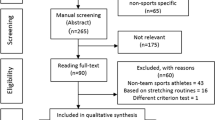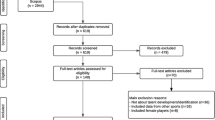Abstract
Background
The most important characteristics of modern handball are the increase of speed and dynamics of attack and defence phase of the game.
Aims
The aim of this work was to determine the differences in attack situational activity indicators between successful and less successful teams in elite men’s handball.
Methods
Overall, 1848 matches of Croatian men’s premier league were analysed. The differences in attack situational activity indicators were determined using a set of 21 variables. Descriptive statistics were calculated for all examined variables of successful and less successful teams. The statistical difference significance in the attack situational activity indicators was tested using the t test analysis.
Results
The results showed statistically significant difference between successful and less successful teams in the following variables: percentage of wing shot efficiency, percentage of 9 ms shot efficiency, average number of counter-attack shots, average number of goals from counter-attack, average number of half-counter-attack goals, average number of half-counter-attack goals, and average number of assistances. Results’ analysis shows that these variables significantly determine the attack situational activity.
Conclusions
In general, we can conclude that handball success was primarily determined by large number of fast attacks on the unorganised defence, as well as efficient realisation of attacks towards the set defence from the demanding situations on the wing and outer positions.
Similar content being viewed by others
References
Rogulj N (2003) Učinkovitost taktičkih modela u rukometu. Doktorska disertacija, kineziološki fakultet u Zagrebu. 235–246 [Efficiency of tactical models in handball (Doctoral thesis) Zagreb: Faculty of Physical Education]
Brzić V (1990) Realizacija napada na dva svjetska rukometna prvenstva. Fizička kultura, 3: 44–45. [Attack realisation on two World Championships. Physical Education 3: pp. 44–45]
Praznik A (1991) Analiza igre glede na čas trajanja in učinkovitost zaključivanja napadov na Svetovnom članskom prvenstvu rokometašev leta 1990 na Čehoslovačkem. (Diplomski rad). Ljubljana: Fakulteta za šport
Dizdar D (1997) Valorizacija jednog metodološkog postupka za prognozu rezultata u nekim sportovima. (Magistarski rad). Zagreb: Fakultet za fizičku kulturu. [Valorisation of a methodological procedure of result prognosis for certain sports (Master thesis). Zagreb: Faculty of Physical Education]
Batinović S (1999) Analiza nekih situacijskih pokazatelja RK “Metković-Jambo” na konačan uspjeh u sezoni 1998/99. (Diplomski rad). Zagreb: Fakultet za fizičku kulturu [Analysis of certain situational indicators of HC “Metković-Jambo” on the final success of season 1998/99 (Diploma thesis). Zagreb: Faculty of Physical Education]
Rogulj N (1990) Utjecaj situacionih struktura kretanja na rezultat rukometne utakmice (Magistarski rad). Sarajevo: Fakultet za fizičku kulturu. [Influence of situational movement structures on the handball match outcome (Master thesis). Sarajevo: Faculty of Physical Education]
Rogulj N (1998) Učinkovitost taktičkih modela u rukometu (Doktorska disertacija). Zagreb: Kineziološki fakultet
Ilić D, Valdevit Z (2010) Utjecaj šuteva sa pozicije krilnog napadača na konačan rezultat utakmice. Zbornik radova 2010, str. 217–225. [Influence of shots from the position of wing attacker on the final match result. Proceedings 2010, pp. 217–225]
Rogulj N, Srhoj V, Čavala M (2005) Učinkovitost elemenata individualne taktike napada u rukometu. Zbornik radova Fakulteta prirodoslovno-matematičkih znanosti I odgojnih područja Sveučilišta u Splitu. Split. 67–78. [Efficiency of individual tactics attack elements in handball. Proceedings of Faculty of Science, pp. 67–78, University of Split]
Zapartidis I, Kororos P, Christodoulidis T, Skoufas D, Bayios I (2011) Profile of young handball players by playing position and determinants of ball throwing velocity. J Human Kinet 27(1):17–30
Vuleta D, Milanović D, Sertić H (2003) Utjecaj varijabli šutiranja na gol na konačan rezultat rukometnih utakmica Europskog prvenstvu 2000. godine, Kineziologija 35 (2), 168–183 [Influences of shot variables on the final result of handball matches at the 2000 European Championship, Kineziologija 35 (2), pp. 168–183]
Vuleta D, ml V, Vuleta (2008) Differences between situation efficiency models of male handball teams at the world championship in Tunisia 2005. In: D. Milanovic i F. Prot (Ur.), Zbornik radova 5. međunarodne znanstvene konferencije o kineziologiji „Kinesiology research trends and appliciations”, 10.–14. 09. 2008., str. 996–999. Zagreb, Kineziološki fakultet Sveučilišta u Zagrebu. [Differences between situation efficiency models of male handball teams at the World championship in Tunisia 2005. In: Milanovic D, Prot F (eds) Proceedings of the 5th International Scientific Conference on Kinesology, “Kinesiology research trends and appliciations”, September 10–14th 2008, pp 996–999, Zagreb, Faculty of Kinesiology]
Gruić I, Vuleta D, Milanović D (2006). Performance indicators of teams at the 2003 Men’s World Handball Championship in Portugal. Kinesiology 38(2), str. 164–175
Srhoj V, Marinović M, Rogulj N (2002) Position specific morphological characteristics of top-level male handball players. Coll Antropol 26(1):219–227
Živković M, Goranović S, Marković S, Brangović N (2010) Relacije morfoloških karakteristika i testova za procjenu eksplozivne snage kod mladih rukometaša. SportLogia 6/1:36–40 [Relations of morphological characteristics and explosive power evaluation tests in young handball players, SportLogia 6/1:36–40]
Vuleta D D, Milanović i sur (2009) Science in handball. Zagreb, Kineziološki fakultet Sveučilišta u Zagrebu
Michalsik LB, Aagaard P, Madsen K (2011a) Technical activity profile and influence of body anthropometry in male elite team handball players. EHF Scientific Conference 2011. Science and Analytical Expertise in Handball. Vienna, 174–179
Michalsik LB, Madsen K, Aagaard P (2011b) Technical match characteristics and influence of body anthropometry in female elite team handball players. EHF Scientific Conference 2011. Science and Analytical Expertise in Handball. Vienna, 180–185
Perkovac G, Vuleta D ml, Vuleta V (2009) Analiza pokazatelja situacijske efikasnosti Hrvatske muške rukometne reprezentacije na 20. Svjetskom prvenstvu u Njemačkoj. Zbornik radova 18. ljetne škole kineziologa Hrvatske, Poreč 2009. [Analysis of situational efficiency of Croatian man’s handball national team at the 20th World Championship in Germany. Proceedings of the 18th Summer School of Kinesiology, Poreč 2009]
Acknowledgements
We wish to thank to project Sunbeam of Erasmus Mundus that allowed us to proceed with our research.
Author information
Authors and Affiliations
Corresponding author
Ethics declarations
Conflict of interest
The authors declare that they have no conflict of interest.
Ethical approval
All methods performed in the study were in accordance with ethical standards of the national research committee and with the 1964 Helsinki Declaration.
Informed consent
The technical and tactical elements of handball games were obtained from Official web page of the Croation Handball Federation.
Rights and permissions
About this article
Cite this article
Bajgoric, S., Rogulj, N., Cavala, M. et al. Difference in attack situational activity indicators between successful and less successful teams in elite men’s handball. Sport Sci Health 13, 515–519 (2017). https://doi.org/10.1007/s11332-017-0348-7
Received:
Accepted:
Published:
Issue Date:
DOI: https://doi.org/10.1007/s11332-017-0348-7




